![]()
![]()
![]()
Use LEFT and RIGHT arrow keys to navigate between flashcards;
Use UP and DOWN arrow keys to flip the card;
H to show hint;
A reads text to speech;
79 Cards in this Set
- Front
- Back
|
• Modernization:
|
technological,economic, and political process associated with the industrial revolution.
|
|
|
• Modernity:
|
the result on social conditions and the modes of experiences associated with modernization
|
|
|
• Modernism:
|
the set of styles of cultural codes that came to be expressive modernity; including modern art. .
|
|
|
• Modern Art:
|
Modern art includes artistic works produced during the period extending roughly from the 1860s to the 1970s, and denotes the style and philosophy of the art produced during that era. The term is usually associated with art in which the traditions of the past have been thrown aside in a spirit of experimentation.
|
|
|
• Abstract Art:
|
uses a visual language of shape, form, color and line to create a composition which may exist with a degree of independence from visual references in the world.
|
|
|
• Representational Art
|
In painting and sculpture, the term "representational art" usually refers to images that are clearly recognizable for what they purport to be,
|
|
|
• Formal analysis
|
A formal analysis is quite simply an analysisof the forms utilized in the work of art. It is a close inspection of the artist's use of aspects such as color, shape, line, mass, and space.
|
|
|
• Composition
|
is the placement or arrangement of visual elements or ingredients in a work of art, as distinct from the subject of a work.
|
|
|
• Chiaroscuro
|
the treatment of light and shade in drawing and painting.an effect of contrasted light and shadow created by light falling unevenly or from a particular direction on something.
|
|
|
• Paint application
|
how the paint is places on a canvas, etc thick, thin, layers |
|
|
• Perspective
|
Approximate representation, on a flat surface (such as paper), of an image as it is seen by the eye. The two most characteristic features of perspective are that objects are smaller as their distance from the observer increases; and that they are subject to foreshortening, meaning that an object's dimensions along the line of sight are shorter than its dimensions across the line of sight.
|
|
|
• Rococo
|
"Late Baroque", is an 18th-century artistic movement and style, affecting many aspects of the arts including painting, sculpture, architecture, interior design,decoration, literature, music, and theatre. It developed in the early 18th century in Paris, France as a reaction against the grandeur, symmetry, and strict regulations of the Baroque, especially of the Palace of Versailles.[1]Rococo artists and architects used a more jocular, florid, and graceful approach to the Baroque. Their style was ornate and used light colours, asymmetrical designs, curves, and gold. Unlike the political Baroque, the Rococo had playful and witty themes.
|
|
|
• Neoclassicism
|
, Rococo was largely replaced by the Neoclassic style. Western movements in the decorative and visual arts, literature, theatre, music, and architecture that draw inspiration from the "classical" art and culture of Ancient Greece or Ancient Rome. Neoclassicism was born in Rome in the mid-18th century, but its popularity spread all over Europe, as a generation of European art students finished their Grand Tour and returned from Italy to their home countries with newly rediscovered Greco-Roman ideals.[2] The main Neoclassical movement coincided with the 18th-century Age of Enlightenment, and continued into the early 19th century, latterly competing with Romanticism. In architecture, the style continued throughout the 19th, 20th and up to the 21st century.
|
|
|
• Romanticism
|
was an artistic, literary, and intellectual movement that originated in Europe toward the end of the 18th century and in most areas was at its peak in the approximate period from 1800 to 1850. Romanticism was characterized by its emphasis on emotion and individualism as well as glorification of all the past and nature, the latter also being celebrated. It was partly a reaction to the Industrial Revolution,[1] the aristocratic social and political norms of the Age of Enlightenment, and the scientific rationalization of nature.[2] It was embodied most strongly in the visual arts, music, and literature, but had a major impact on historiography,[3] education,[4] and the natural sciences.[5] It had a significant and complex effect on politics, and while for much of the Romantic period it was associated with liberalism and radicalism, its long-term effect on the growth of nationalism was perhaps more significant.
|
|
|
• Realism
|
is the attempt to represent subject matter truthfully, without artificiality and avoiding artistic conventions, implausible, exotic and supernatural elements.
|
|
|
• Enlightenment
|
philosophical movement which dominated the world of ideas in Europe in the 18th century. The principal goals of Enlightenment thinkers were liberty, progress, reason, tolerance, fraternity, and ending the abuses of the church and state.[1][2] In France, the central doctrines of the Lumières were individual liberty and religious tolerance, in opposition to the principle of absolute monarchy and the fixed dogmas of the Roman Catholic Church.[3] The Enlightenment was marked by increasing empiricism, scientific rigor, and reductionism, along with increased questioning of religious orthodoxy
|
|
|
• Orientalism
|
is a term used by art historians, literary, geographers, and cultural studies scholars for the imitation or depiction of aspects in Middle Eastern, South Asian, African and East Asian cultures (Eastern cultures). These depictions are usually done by writers, designers, and artists from the West. In particular, Orientalist painting, depicting more specifically "the Middle East",[1] was one of the many specialisms of 19th-century Academic art, and the literature of Western countries took a similar interest in Oriental themes.
|
|
|
• French Revolution
|
was a period of far-reaching social and political upheaval in France that lasted from 1789 until 1799, and was partially carried forward byNapoleon during the later expansion of the French Empire. The Revolution overthrew the monarchy, established a republic, experienced violent periods of political turmoil, and finally culminated in a dictatorship under Napoleon that rapidly brought many of its principles to Western Europe and beyond. Inspired by liberal and radical ideas, the Revolution profoundly altered the course of modern history, triggering the global decline of absolute monarchies while replacing them with republics and liberal democracies
|
|
|
• Industrial Revolution
|
The Industrial Revolution, which took place from the 18th to 19th centuries, was a period during which predominantly agrarian, rural societies in Europe and America became industrial and urban.
|
|
|
• Napoleon Bonaparte
|
was a French military and political leader who rose to prominence during theFrench Revolution and led several successful campaigns during the Revolutionary Wars. As Napoleon I, he was Emperor of the French from 1804 until 1814, and again in 1815. Napoleon dominated European affairs for over a decade while leading France against a series of coalitions in the Napoleonic Wars. He won most of these wars and the vast majority of his battles, rapidly gaining control of continental Europe before his ultimate defeat in 1815. One of the greatest commanders in history, his campaigns are studied at military schools worldwide and he remains one of the most celebrated and controversial political figures in Western history.[3][4] In civil affairs, Napoleon had a major long-term impact by bringing liberal reforms to the territories that he conquered, especially the Low Countries, Switzerland, and large parts of modern Italy and Germany. He implemented fundamental liberal policies in France and throughout Western Europe.[note 1] His lasting legal achievement, the Napoleonic Code, has been adopted in various forms by a quarter of the world's legal systems, from Japan to Quebec
|
|
|
• 1848 Revolution
|
The 1848 Revolution in France, sometimes known as the February Revolution (révolution de Février), was one of a wave of revolutions in 1848 in Europe. In France the revolutionary events ended the Orleans monarchy (1830–48) and led to the creation of the French Second Republic.
|
|
|
• The Royal Academy
|
he Royal Academy of Arts was founded through a personal act of King George III on 10 December 1768 with a mission to promote the arts of design in Britain through education and exhibition. The motive in founding the Academy was twofold: to raise the professional status of the artist by establishing a sound system of training and expert judgement in the arts, and to arrange the exhibition of contemporary works of art attaining an appropriate standard of excellence. Supporters wanted to foster a national school of art and to encourage appreciation and interest in the public based on recognised canons of good taste.Fashionable taste in 18th-century Britain was based on continental and traditional art forms, providing contemporary British artists little opportunity to sell their works.
|
|
|
• Genres
|
kind" or "sort", from Latin genus (stem gener-), Greek γένος, gés) is any category of literature, music or other forms of art or entertainment, whether written or spoken, audio or visual, based on some set of stylistic criteria. Genres form by conventions that change over time as new genres are invented and the use of old ones is discontinued. Often, works fit into multiple genres by way of borrowing and recombining these conventions.
|
|
|
• History Painting, Landscape Painting, Genre Painting
|
A hierarchy of genres is any formalization which ranks different genres in an art form in terms of their prestige and cultural value.In literature, the epic was considered the highest form, for the reason expressed by Samuel Johnson in his Life of John Milton: "By the general consent of criticks, the first praise of genius is due to the writer of an epick poem, as it requires an assemblage of all the powers which are singly sufficient for other compositions." Below that came lyric poetry, and comic poetry, with a similar ranking for drama. The novel took a long time to establish a firm place in the hierarchy, doing so only as belief in any systematic hierarchy of forms expired in the 19th century.In music, settings of words were accorded a higher status than merely instrumental works, at least until the Baroque period, and opera retained a superior status for much longer. The status of works also varies with the number of players and singers involved, with those for large forces, which are certainly more difficult to write and more expensive to perform, given higher status. Any element of comedy reduced the status of a work, though, as in other art forms, often increasing its popularity.The hierarchies in figurative art are those initially formulated for painting in 16th century Italy, which held sway with little alteration until the early 19th century. These were formalized and promoted by the academies in Europe between the 17th century and the modern era, of which the most influential became the French Académie de peinture et de sculpture, which held a central role in Academic art. The fully developed hierarchy distinguished between:History painting, including narrative religious mythological and allegorical subjects Portrait painting-genre painting or scenes of everyday life Landscape and cityscape (landscapists were called "common footmen in the Army of Art" by the Dutch theorist Samuel van Hoogstraten)Animal paintingStill life
|
|
|
• Caricature
|
"lower form or art" common, easy to understand, simple. |
|
|
• Medium
|
paint, watercolor, stone, sculpture |
|
|
• Lithography
|
from Ancient Greek λίθος, lithos, meaning "stone", and γράφειν, graphein, meaning "to write") is a method of printing originally based on the immiscibility of oil and water. The printing is from a stone (lithographic limestone) or a metal plate with a smooth surface.
|
|
|
• Pre-Raphaelites
|
was a group of English painters, poets, and critics, founded in 1848 by William Holman Hunt, John Everett Millais and Dante Gabriel Rossetti. The three founders were joined by William Michael Rossetti, James Collinson, Frederic George Stephens and Thomas Woolner to form the seven-member "brotherhood". Their principles were shared by other male and female artists, notably Marie Spartali Stillman.The group's intention was to reform art by rejecting what it considered the mechanistic approach first adopted by Mannerist artists who succeeded Raphael and Michelangelo. Its members believed the Classical poses and elegant compositions of Raphael in particular had been a corrupting influence on the academic teaching of art, hence the name "Pre-Raphaelite". In particular, the group objected to the influence of Sir Joshua Reynolds, founder of the English Royal Academy of Arts, whom they called "Sir Sloshua". To the Pre-Raphaelites, according to William Michael Rossetti, "sloshy" meant "anything lax or scamped in the process of painting ... and hence ... any thing or person of a commonplace or conventional kind".[1] The brotherhood sought a return to the abundant detail, intense colours and complex compositions of Quattrocento Italian art. The group associated their work with John Ruskin,[2] an English artist whose influences were driven by his religious background.
|
|
|
• Victorian Age
|
Victoria became queen in 1837 at age 18. Her long reign until 1901 was generally characterized mostly by peace and prosperity
|
|
|
• Beaux-Arts architecture
|
Beaux Arts architecture style is a theatrical and heavily ornamented classical style taught during the 19th century at the Ecole desBeaux-Arts in Paris. This style strongly considers the function of the space.
|
|
|
• Eclecticism
|
s a conceptual approach that does not hold rigidly to a single paradigm or set of assumptions, but instead draws upon multiple theories, styles, or ideas to gain complementary insights into a subject, or applies different theories in particular cases.
|
|
|
• George Haussmann
|
was the Prefect of the Seine Department in France, who was chosen by the Emperor Napoleon III to carry out a massive program of new boulevards, parks and public works in Paris, commonly called Haussmann's renovation of Paris.[1] Critics forced his resignation for extravagance, but his vision of the city still dominates Central Paris.
|
|
|
• Chicago School
|
The style is also known as Commercial style.[1] In the history of architecture, the Chicago School was a school of architects active in Chicago at the turn of the 20th century. They were among the first to promote the new technologies of steel-frame construction in commercial buildings, and developed a spatial aesthetic which co-evolved with parallel developments in European Modernism. A "Second Chicago School" later emerged in the 1940s and 1970s which pioneered new building technologies and structural systems such as the tube-frame structure.
|
|
|
• Form Follows Function
|
is a principle associated with modernist architecture and industrial design in the 20th century. The principle is that the shape of a building or object should be primarily based upon its intended function or purpose.
|
|
|
• Load-bearing structure
|
A load-bearing wall or bearing wall is a wall that bears a load resting upon it by conducting its weight to a foundation structure. The materials most often used to construct load-bearing walls in large buildings are concrete, block, or brick.By contrast, a curtain wall provides no significant structural support beyond what is necessary to bear its own materials or conduct such loads to a load-bearing wall
|
|
|
• Metal skeleton
|
is a building technique with a "skeleton frame" of vertical steel columns and horizontal I-beams, constructed in a rectangular grid to support the floors, roof and walls of a building which are all attached to the frame. The development of this technique made the construction of the skyscraper possible.
|
|
|
• Arts and Crafts Movement
|
The Arts and Crafts movement was an international movement in the decorative and fine arts that flourished in Europe and North America between 1880 and 1910,[1] emerging in Japan in the 1920s. It stood for traditional craftsmanship using simple forms, and often used medieval, romantic or folk styles of decoration. It advocated economic and social reform and was essentially anti-industrial.[2][3][4] It had a strong influence on the arts in Europe until it was displaced by Modernism in the 1930s,[5] and its influence continued among craft makers, designers and town planners long afterwards.[
|
|
|
• Art Nouveau
|
a style of decorative art, architecture, and design prominent in western Europe and the US from about 1890 until World War I and characterized by intricate linear designs and flowing curves based on natural forms.
|
|
|
• Middle Ages
|
he Middle Ages is the middle period of the three traditional divisions of Western history: Antiquity, Medieval period, and Modern period. The Medieval period is itself subdivided into the Early, the High, and the Late Middle Ages.
|
|
|
• John Ruskin
|
0 January 1900) was the leading English art critic of the Victorian era, also an art patron, draughtsman, watercolourist, a prominent social thinker and philanthropist. He wrote on subjects as varied as geology, architecture, myth, ornithology, literature, education, botany and political economy. His writing styles and literary forms were equally varied. Ruskin penned essays and treatises, poetry and lectures, travel guides and manuals, letters and even a fairy tale. The elaborate style that characterised his earliest writing on art was later superseded by a preference for plainer language designed to communicate his ideas more effectively. In all of his writing, he emphasised the connections between nature, art and society. He also made detailed sketches and paintings of rocks, plants, birds, landscapes, and architectural structures and ornamentation.He was hugely influential in the latter half of the 19th century, and up to the First World War. After a period of relative decline, his reputation has steadily improved since the 1960s with the publication of numerous academic studies of his work. Today, his ideas and concerns are widely recognised as having anticipated interest in environmentalism, sustainability and craft.Ruskin first came to widespread attention with the first volume of Modern Painters (1843), an extended essay in defence of the work of J. M. W. Turner in which he argued that the principal role of the artist is "truth to nature". From the 1850s he championed the Pre-Raphaelites who were influenced by his ideas. His work increasingly focused on social and political issues. Unto This Last (1860, 1862) marked the shift in emphasis. In 1869, Ruskin became the first Slade Professor of Fine Art at the University of Oxford, where he established the Ruskin School of Drawing. In 1871, he began his monthly "letters to the workmen and labourers of Great Britain", published under the title Fors Clavigera (1871–1884). In the course of this complex and deeply personal work, he developed the principles underlying his ideal society. As a result, he founded the Guild of St George, an organisation that endures today.
|
|
|
• Aesthetic avant-garde
|
"vanguard", literally "fore-guard")[1] are people or works that are experimental or innovative, particularly with respect to art, culture, and politics.The avant-garde pushes the boundaries of what is accepted as the norm or the status quo, primarily in the cultural realm. The avant-garde is considered by some to be a hallmark of modernism, as distinct frompostmodernism. Many artists have aligned themselves with the avant-garde movement and still continue to do so, tracing a history from Dada through the Situationists to postmodern artists such as the Language poets around 1981.[2]The avant-garde also promotes radical social reforms. It was this meaning that was evoked by the Saint Simonian Olinde Rodrigues in his essay "L'artiste, le savant et l'industriel" ("The artist, the scientist and the industrialist", 1825), which contains the first recorded use of "avant-garde" in its now customary sense: there, Rodrigues calls on artists to "serve as [the people's] avant-garde", insisting that "the power of the arts is indeed the most immediate and fastest way" to social, political and economic reform.[3]
|
|
|
• Political avant-garde
|
The avant-garde pushes the boundaries of what is accepted as the norm or the status quo, primarily in the cultural realm. The avant-garde is considered by some to be a hallmark of modernism, as distinct frompostmodernism. Many artists have aligned themselves with the avant-garde movement and still continue to do so, tracing a history from Dada through the Situationists to postmodern artists such as the Language poets around 1981.[2]
|
|
|
• Charles Baudelaire
|
His most famous work, Les Fleurs du mal (The Flowers of Evil), expresses the changing nature of beauty in modern, industrializing Paris during the 19th century. Baudelaire's highly original style of prose-poetry influenced a whole generation of poets including Paul Verlaine, Arthur Rimbaud and Stéphane Mallarmé among many others. He is credited with coining the term "modernity" (modernité) to designate the fleeting, ephemeral experience of life in an urban metropolis, and the responsibility art has to capture that experience.[2]
|
|
|
• Impressionism
|
mpressionism is a 19th-century art movement that originated with a group of Paris-based artists whose independent exhibitions brought them to prominence during the 1870s and 1880s. Impressionist painting characteristics include relatively small, thin, yet visible brush strokes, open composition, emphasis on accurate depiction of light in its changing qualities (often accentuating the effects of the passage of time), ordinary subject matter, inclusion of movement as a crucial element of human perception and experience, and unusual visual angles.The Impressionists faced harsh opposition from the conventional art community in France. The name of the style derives from the title of a Claude Monet work, Impression, soleil levant (Impression, Sunrise), which provoked the critic Louis Leroy to coin the term in a satirical review published in the Parisian newspaper Le Charivari.The development of Impressionism in the visual arts was soon followed by analogous styles in other media that became known as impressionist music and impressionist literatur
|
|
|
• Neo-Impressionism
|
Neo-Impressionism is a term coined by French art critic Félix Fénéon in 1886 to describe an art movement founded by Georges Seurat. Seurat’s greatest masterpiece, A Sunday Afternoon on the Island of La Grande Jatte, marked the beginning of this movement when it first made its appearance at an exhibition of the Société des Artistes Indépendants (Salon des Indépendants) in Paris.[1] Around this time, the peak of France’s modern era emerged and many painters were in search of new methods. Followers of Neo-Impressionism, in particular, were drawn to modern urban scenes as well as landscapes and seashores. Science-based interpretation of lines and colors influenced Neo-Impressionists' characterization of their own contemporary art.[2] The Pointillist and Divisionist techniques are often mentioned in this context, because it was the dominant technique in the beginning of the Neo-impressionist movement.Some argue that Neo-Impressionism became the first true avant-garde movement in painting.[3] The Neo-Impressionists were able to create a movement very quickly in the 19th century, partially due to its strong connection to anarchism, which set a pace for later artistic manifestations.[3] The movement and the style were an attempt to drive "harmonious" vision from modern science, anarchist theory, and late 19th-century debate around the value of academic art. The artists of the movement "promised to employ optical and psycho-biological theories in pursuit of a grand synthesis of the ideal and the real, the fugitive and the essential, science and temperament."[1]
|
|
|
• Salon des Independants, 1874
|
The Salon des Refusés, French for "exhibition of rejects" (French pronunciation: [salɔ̃ de ʁəfyze]), is generally an exhibition of works rejected by the jury of the official Paris Salon, but the term is most famously used to refer to the Salon des Refusés of 1863.[1]Today by extension, salon des refusés refers to any exhibition of works rejected from a juried art show.
|
|
|
• Plein-air painting
|
En plein air (French pronunciation: [ɑ̃ plɛn ɛːʁ]), or plein air painting, is a phrase borrowed from the French equivalent meaning "open (in full) air". It is particularly used to describe the act of painting outdoors, also called French: peinture sur le motif ("painting of the object(s) or what the eye actually sees"), where a painter reproduces the actual visual conditions seen at the time of the painting. This method contrasts with studio painting or academic rules; those might create a predetermined look. En plein air can also be used to describe other activities where a person partakes in an outdoor environmen
|
|
|
• Pointilism
|
www.ducksters.comPointillism /ˈpɔɪntᵻlɪzəm/ is a technique of painting in which small, distinct dots of color are applied in patterns to form an image. Georges Seurat and Paul Signac developed the technique in 1886, branching from Impressionism.
|
|
|
• Simultaneous contrast
|
Simultaneous contrast refers to the way in which two different colors affect each other, how one color can change how we perceive the tone and hue of another when placed side by side. The colors themselves don't change, but we see them as altered.Simultaneous contrast was first described by the 19th century French chemist Michel Eugène Chevreul in his famous book on color theoryThe Principle of Harmony and Contrast of Colors, published in 1839 (translated into English in 1854).
|
|
|
• Divisionism
|
(also called Chromoluminarism) was the characteristic style in Neo-Impressionist painting defined by the separation of colors into individual dots or patches which interacted optically.
|
|
|
• Complementary colors
|
are pairs of colors which, when combined, cancel each other out. This means that when combined, they produce a grey-scalecolor like white or black. When placed next to each other, they create the strongest contrast for those particular two colors.
|
|
|
• Japonisme
|
or Japonism, is a French term that was first used by Jules Claretie in his book L'Art Francais en 1872. It refers to the influence of Japanese art on Western art.
|
|
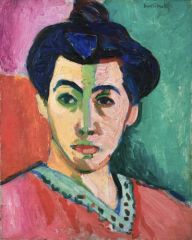
|
Henri Matisse, Green Stripe, 1905
|
|
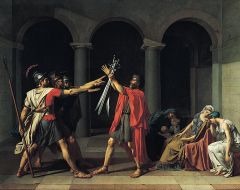
|
Oath of the Horatii (French: Le Serment des Horaces), is a large painting by the French artist Jacques-Louis David painted in 1784and now on display in the Louvre in Paris. The painting immediately became a huge success with critics and the public, and remains one of the best known paintings in the Neoclassical style.
|
|

|
The Death of Marat (French: La Mort de Marat orMarat Assassiné) is a painting by Jacques-Louis David of the murdered French revolutionary leader Jean-Paul Marat. It is one of the most famous images of the Revolution.
|
|

|
• Antoine-Jean Gros, Napoleon in the Plague House, 1804. , was both a French history and neoclassical painter.
|
|

|
• Théodore Géricault, The Raft of the Medusa, 1819 . Icon of French Romanticism. It is an over-life-size painting that depicts a moment from the aftermath of the wreck of the French naval frigateMéduse, which ran aground off the coast of today's Mauritania on 2 July 1816. On 5 July 1816, at least 147 people were set adrift on a hurriedly constructed raft; all but 15 died in the 13 days before their rescue, and those who survived endured starvation and dehydration and practiced cannibalism. The event became an international scandal, in part because its cause was widely attributed to the incompetence of the French captain.
|
|

|
• Eugene Delacroix, The 28th of July: Liberty Leading the People, 1830 . By the time Delacroix painted Liberty Leading the People, he was already the acknowledged leader of the Romantic school in French painting.[2] Delacroix, who was born as the Age of Enlightenment was giving way to the ideas and style of romanticism, rejected the emphasis on precise drawing that characterised the academic art of his time, and instead gave a new prominence to freely brushed colour.
|
|
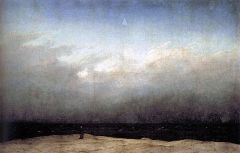
|
The Monk by the Sea (German: Der Mönch am Meer) is an oil painting by the German Romantic artist Caspar David Friedrich. It was painted between 1808 and 1810 in Dresden and was first shown together with the painting The Abbey in the Oakwood (Abtei im Eichwald) in the Berlin Academy exhibition of 1810. On Friedrich's request The Monk by the Sea was hung above The Abbey in the Oakwood.[1]After the exhibition both pictures were bought by king Frederick Wilhelm III for his collection.[2] Today the paintings hang side by side in the Alte Nationalgalerie, Berlin.For its lack of concern with creating the illusion of depth—which had been a traditional aspect of landscape painting—The Monk by the Sea was Friedrich's most radical composition. The broad expanses of sea and sky emphasize the meager figure of the monk, standing before the vastness of nature and the presence of God.[3]
|
|
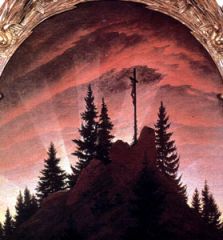
|
• Caspar David Friedrich, Cross in the Mountains, 1807-08This was one of Caspar David Friedrich's earliest, and most controversial paintings. Finished in 1807, he exhibited The Cross in the Mountains in the following year in a frame which he had made himself. The whole was designed to serve as the center piece of an altar. For the first time in Christian art, an altarpiece was conceived in terms of a pure landscape. The cross, viewed obliquely from behind, is an insignificant element in the composition. More important are the dominant rays of the evening sun, which the artist said depicted the setting of the old, pre-Christian world. The mountain symbolizes an immovable faith, while the fir trees are an allegory of hope.
|
|
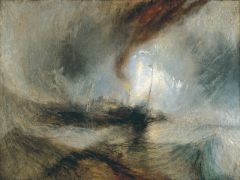
|
• William Turner, Snowstorm, Steamboat Off a Harbor's Mouth, 1842. Romantic era's painter's depiction of a snowstorm on water at its best, fully developing the bold, daring Romantic fantasy of Turner. Turner was unrivaled in depicting the natural world unmastered by mankind and exploring the effects of the elements and the battle of the forces of the nature. Turner worked first as a watercolorist, and he started to work much later with oils. He later applied the techniques he learned in watercolour onto oil paintings.[5]
|
|
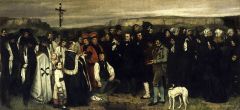
|
A Burial At Ornans (French: Un enterrement à Ornans, also known as A Funeral At Ornans) is a painting of 1849–50 by Gustave Courbet, and one of the major turning points of 19th-century French art. The painting records the funeral in September 1848 of his great-uncle in the painter's birthplace, the small town of Ornans.[1] It treats an ordinary provincial funeral with unflattering realism, and on the giant scale traditionally reserved for the heroic or religious scenes of history painting. Its exhibition at the 1850–51 Paris Salon created an "explosive reaction" and brought Courbet instant fame.[2] It is currently displayed at the Musée d'Orsay in Paris, France.The Salon[3] found Courbet triumphant with The Stone Breakers, the Peasants of Flagey, and A Burial at Ornans. People who had attended the funeral were used as models for the painting. Previously, models had been used as actors in historical narratives; here Courbet said that he "painted the very people who had been present at the interment, all the townspeople". The result is a realistic presentation of them, and of life, in Ornans.The painting, which drew both praise and fierce denunciations from critics and the public, is an enormous work, measuring 10 by 22 feet (3.1 by 6.6 metres), depicting a prosaic ritual on a scale which previously would have been reserved for a work of history painting. According to art historian Sarah Faunce, "In Paris the Burial was judged as a work that had thrust itself into the grand tradition of history painting, like an upstart in dirty boots crashing a genteel party, and in terms of that tradition it was of course found wanting."[4] Then too, the painting lacks the sentimental rhetoric that was expected in agenre work: Courbet's mourners make no theatrical gestures of grief, and their faces seem more caricatured than ennobled. The critics accused Courbet of a deliberate pursuit of ugliness. Eventually the public grew more interested in the new Realist approach, and the lavish, decadent fantasy of Romanticism lost popularity. The artist well understood the importance of this painting; Courbet said: "The Burial at Ornans was in reality the burial of Romanticism."[5] It might also be said to be the burial of the hierarchy of genres which had dominated French art since the 17th century.In 1873, when Courbet's political views had changed, he repudiated the work saying that it was "worth nothing".[6]
|
|
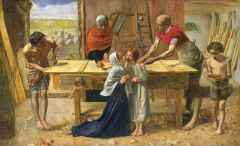
|
• John Everett Millais, Christ in the Carpenter's Shop, 1849-50 Christ in the House of His Parents (1849–50) is a painting by John Everett Millais depicting the Holy Family in Saint Joseph's carpentry workshop. The painting was extremely controversial when first exhibited, prompting many negative reviews, most notably one written by Charles Dickens. It catapulted the previously obscure Pre-Raphaelite Brotherhood to notoriety and was a major contributor to the debate aboutRealism in the arts.It is currently housed in the Tate Britain in London.The painting depicts the young Jesus assisting Joseph in his workshop. Joseph is making a door, which is laid on his carpentry work-table. Jesus has cut his hand on an exposed nail, leading to a sign of thestigmata, prefiguring the crucifixion. As Saint Anne removes the nail with a pair of pincers, his concerned mother Mary offers her cheek for a kiss while Joseph examines his wounded hand. The young John the Baptist brings in water to wash the wound, prefiguring his later baptism of Christ. An assistant of Joseph's, representing potential future Apostles, watches these events. In the background various objects are used to further point up the theological significance of the subject. A ladder, referring to Jacob's Ladder, is visible leaning against the back wall; a dove standing for the Holy Spirit rests on it. Other carpentry implements refer to the Holy Trinity. Millais probably usedAlbrecht Dürer's print Melancholia I as a source for this imagery, along with quattrocento works. The sheep in the fold in the background represent the future Christian flock.[1]It has been suggested that Millais was influenced by John Rogers Herbert's painting Our Saviour Subject to His Parents at Nazareth.[2] He may also have drawn on a painting depicting Jesus helping Joseph in his workshop, which at the time was attributed toAnnibale Carracci.[3]
|
|

|
Ophelia is a painting by British artist Sir John Everett Millais, completed between 1851 and 1852. It is held in the Tate Britain in London. It depicts Ophelia, a character from William Shakespeare's play Hamlet, singing before she drowns in a river in Denmark. Romanticism, Pre-Raphaelite Brotherhood
|
|
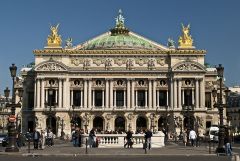
|
30 December 1860 the Second Empire of Emperor Napoleon III announced a competition for the design of a new, state-funded opera house. The old opera house, located on the rue Le Peletier[fr] and known as theSalle Le Peletier, had been constructed as a temporary theatre in 1821. Street access to that theatre was greatly constricted, and after an attempted assassination of Napoleon III at the theatre's entrance on 14 January 1858, it was decided to build a new opera house with a separate, more secure entrance for the head of state.[1]Applicants were given a month to submit entries. There were two phases to the competition, and Garnier was one of 170[dubious – discuss] entrants in the first phase. He was awarded the fifth-place prize and was one of seven finalists selected for the second phase.[2] The second phase required the contestants to revise their original projects and was more rigorous, with a 58-page program, written by the director of the Opéra, Alphonse Royer, which the contestants received on 18 April. The new submissions were sent to the jury in the middle of May, and on 29 May Garnier's project was selected for its "rare and superior qualities in the beautiful distribution of the plans, the monumental and characteristic aspect of the facades and sections".[3]Garnier's wife Louise later wrote that the French architect Alphonse de Gisors, who was on the jury, had commented to them that Garnier's project was "remarkable in its simplicity, clarity, logic, grandeur, and because of the exterior dispositions which distinguish the plan in three distinct parts—the public spaces, auditorium, and stage ... 'you have greatly improved your project since the first competition; whereas Ginain [the first-place winner in the first phase] has ruined his.'"[3]Soon the thirty-five-year-old and relatively unknown Garnier began work on the building, which eventually would be named for him, the Palais Garnier. Many people had difficulty in deciding exactly what style he was trying to portray. When asked by Empress Eugénie in what style the building was to be done, he is said to have replied: "Why Ma'am, in Napoleon Trois, and you complain!"[4]Construction began in the summer of 1861, though setbacks would delay it for another fourteen years. During the first week of excavation, an underground stream was discovered, rendering the ground too unstable for a foundation. It required eight months for the water to be pumped out, though enough was left in the area which eventually became the fifth cellar for operating the hydraulic stage machinery above. Garnier's double-walled and bitumen-sealed cement and concrete foundation proved strong enough to withstand any possible leakages, and construction continued.The defeat of the French army by the Prussians at the Battle of Sedan in 1870 resulted in the end of the Second Empire. During the Siege of Paris and the Paris Commune in 1871, the unfinished Opera was used as a warehouse for goods, as well as a military prison.The opera house was finally inaugurated on 5 January 1875. Many of the most prestigious monarchs of Europe attended the opening ceremony, including the President of France's new Republic, Marshal MacMahon, the Lord Mayor of London, and King Alfonso XII of Spain.The people who entered the massive building, spanning nearly 119,000 square feet (11,100 m2), were generally awed by its immense size and extensive ornamentation. Claude Debussy described it as resembling a railway station on the outside, and that the interior could easily be mistaken for a Turkish bath.[citation needed]Garnier's works represent a Neo-Baroque-inspired style, popular during the Beaux-Arts period in France. He was influenced by the Italianate styles of Renaissance artisans such as Palladio, Sansovino, and Michelangelo, perhaps[citation needed] the result of his many visits to Greece and Rome during his lifetime. He was also a pioneer of architectural beauty as well as function; his opera was built on a framework of metal girders, unprecedented at the time. Aside from being fireproof, steel and iron was much stronger than wood, allowing it to successfully withstand the countless heavy tons of marble and other materials heaped upon it without breaking.
|
|
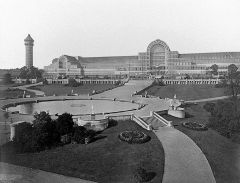
|
The Crystal Palace was a cast-iron and plate-glass structure erected in Hyde Park, London, England, to house the Great Exhibition of 1851. More than 14,000 exhibitors from around the world gathered in its 990,000 square feet (92,000 m2) exhibition space to display examples of technology developed in the Industrial Revolution. Designed by Sir Joseph Paxton, the Great Exhibition building was 1,851 feet (564 m) long, with an interior height of 128 feet (39 m).[1] The invention of the cast plate glass method in 1848 made possible the production of large sheets of cheap but strong glass, and its use in the Crystal Palace created a structure with the greatest area of glass ever seen in a building and astonished visitors with its clear walls and ceilings that did not require interior lights.
|
|
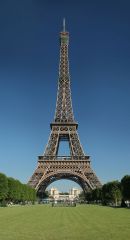
|
• Gustave Eiffel, Eiffel Tower, Paris, 1887-89 The Eiffel Tower (/ˈaɪfəl ˈtaʊər/ eye-fəl towr; French: tour Eiffel [tuʁ‿ɛfɛl] listen) is a wrought iron lattice tower on the Champ de Mars in Paris, France. It is named after the engineer Gustave Eiffel, whose company designed and built the tower. Constructed in 1889 as the entrance to the 1889 World's Fair, it was initially criticized by some of France's leading artists and intellectuals for its design, but has become a global cultural iconof France and one of the most recognisable structures in the world.
|
|
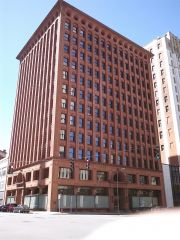
|
• Louis Sullivan, Guaranty Building, Buffalo, NY, 1894-95The Guaranty Building, now called the Prudential Building, is an early skyscraper in Buffalo, New York. It was completed in 1896 and was designed by Louis Sullivan and Dankmar Adler.Sullivan's design for the building was based on his belief that "form follows function". He and Adler divided the building into four zones. The basement was the mechanical and utility area. Since this level was below ground, it did not show on the face of the building. The next zone was the ground-floor zone which was the public areas for street-facing shops, public entrances and lobbies. The third zone was the office floors with identical office cells clustered around the central elevator shafts. The final zone was the terminating zone, consisting of elevator equipment, utilities and a few offices.[3]The supporting steel structure of the building was embellished with terra cotta blocks. Different styles of block delineated the three visible zones of the building. Writing in his Kindergarten Chats, Sullivan said that a tall building "must be every inch a proud and soaring thing, rising in sheer exultation that from bottom to top it is a unit without a single dissenting line
|
|
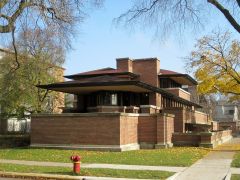
|
The Frederick C. Robie House is a U.S. National Historic Landmark on the campus of the University of Chicago in the neighborhood of Hyde Park in Chicago, Illinois, at 5757 S. Woodlawn Avenue on the South Side. It was designed and built between 1908 and 1910 by architect Frank Lloyd Wright and is renowned as the greatest example of the Prairie School style, the first architectural style that was uniquely American. It was designated a National Historic Landmark on November 27, 1963[4] and was on the very first National Register of Historic Places list of October 15, 1966.[1]
|
|

|
• Ernest Langford, Administration Building, Texas A&M University, College Station, 1932
|
|

|
• William Morris, Philip Webb, and others, Red House, Bexley Heath, Kent, 1859 . Red House is a significant Arts and Crafts building located in the town of Bexleyheath in Southeast London, England. Co-designed in 1859 by the architect Philip Webb and the designer William Morris, it was created to serve as a family home for the latter, with construction being completed in 1860. It is recognised as one of the most important examples of nineteenth-century British architecture still extant.Following an education at the University of Oxford, Morris decided to construct a rural house for him and his new wife, Jane Morris, within a commuting distance of central London. Purchasing a plot of land in what at the time was the village of Upton in Kent, he employed his friend Webb to help him design and construct the house, financing the project with money inherited from his wealthy family. Morris was deeply influenced byMedievalism and Medieval-inspired Neo-Gothic styles are reflected throughout the building's design. It was constructed using Morris' ethos on craftsmanship and artisan skills, thus reflecting an early example of what came to be known as the Arts and Crafts movement.A number of Morris' friends visited, most notably the Pre-Raphaelite painters Edward Burne-Jones and Dante Gabriel Rossetti, both of whom aided him in decorating the House; various Burne-Jones wall murals remain. While at Red House, Morris was involved in the formation of his design company, Morris, Marshall, Faulkner & Co., and embarked on his earliest wallpaper designs. It was also here that his two daughters, Jenny and May, were born. Although initially intending to live there for the rest of his life, Morris found that it proved too expensive to run and did not suit his lifestyle, moving out and selling the property after five years.Red House remained a private residence for various individuals from 1866 to 2002, during which various alterations were made to the interior design. From 1952 to 1999 the architect Edward Hollamby lived at the House, initiating attempts at preservation and establishing the Friends of Red House charity in 1998. The House was purchased for The National Trust in 2003, who have since undertaken a project of conservation and maintain it as a visitor's attraction with accompanying tea room and gift shop.
|
|
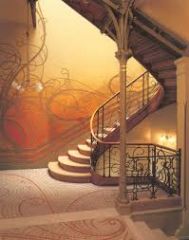
|
The Hotel Tassel (French: Hôtel Tassel, Dutch: Hotel Tassel) is a town house built by Victor Horta in Brussels for the Belgian scientist and professor Emile Tassel in 1893–1894. It is generally considered as the first trueArt Nouveau building, because of its highly innovative plan and its groundbreaking use of materials and decoration. Together with three other town houses of Victor Horta, including Horta's own house and atelier, it was put on the 'UNESCO World Heritage List' in 2000. It is located at 6, Rue Paul-Emile Jansonstraat in Brussels. Art Nouveau
|
|
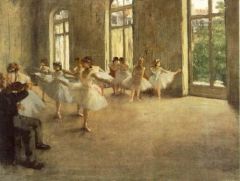
|
• Edgar Degas, Ballet Rehearsal, 1891 : Impressionism
|
|
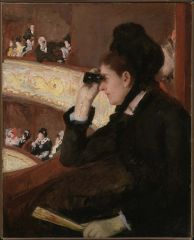
|
• Mary Cassatt, In the Loge, 1878
In The Loge is an 1878 Impressionist painting by American artist Mary Cassatt. It depicts a woman at the Garnier Opera using opera glasses to examine the audience, while she herself is being spied upon by another gentleman in the audience. This piece demonstrates various types of gaze within a painting, that of the audience (male), the subject and a putti. This example is exemplified in Édouard Manet's pieceOlympia. |
|
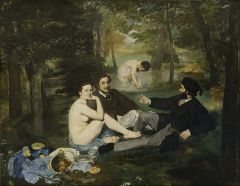
|
• Edouard Manet, Dejeuner sur l'herbe (Luncheon on the Grass), 1863 . Le Déjeuner sur l'herbe (English: The Luncheon on the Grass) – originally titled Le Bain (The Bath) – is a large oil on canvas painting by Édouard Manet created in 1862 and 1863. The painting depicts afemale nude and a scantily dressed female bather on a picnic with two fully dressed men in a rural setting. Rejected by the Salon jury of 1863, Manet seized the opportunity to exhibit this and two other paintings in the 1863 Salon des Refusés[1] where the painting sparked public notoriety and controversy. The piece is now in the Musée d'Orsay in Paris.[2] A smaller, earlier version can be seen at theCourtauld Gallery, London.[3]
|
|
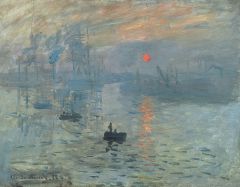
|
• Claude Monet, Impression: Sunrise, 1872 Impression, Sunrise (French: Impression, soleil levant) is a painting by Claude Monet. Shown at what would later be known as the "Exhibition of the Impressionists" in April 1874, the painting is attributed to giving rise to the name of the Impressionist movement. Impression, Sunrise depicts the port of Le Havre, Monet's hometown, and is his most famous painting of the harbor.
|
|
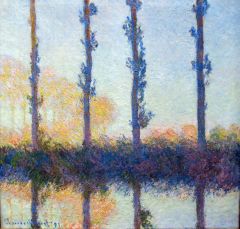
|
• Claude Monet, Poplars, 1891 The Poplar Series paintings were made by Claude Monet in the summer and fall of 1891. The magnificent trees were in a marsh along the banks of the Epte River a few kilometers upstream from Monet's home and studio. To reach his floating painting studio that was moored in place he went by small boat up the nearby waterway to where it joined the mainstream. The trees were along the riverside in single file, following along an S-curve. There were three groups of paintings — in one group the paintings have towering Poplars that go off the top edge of the canvas, in another group there are seven trees, and in another group three or four Poplars on the banks of the Epte River near Giverny. The trees which actually belonged to the commune of Limetz were put up for auction before Monet had completed all of his paintings. At a certain point Monet was forced into buying the trees because he still wasn't finished with his paintings. After he finished the series he sold the trees back to the lumber merchant who wanted them.[1]
|
|
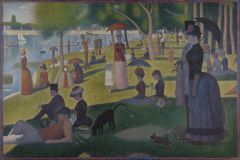
|
• Georges Seurat, Sunday Afternoon on the Island La Grande Jatte, 1884-6 n 1879 Georges Seurat enlisted as a soldier in the French army and was back home by 1880. Later, he ran a small painter’s studio in Paris, and in 1883 showed his work publicly for the first time. The following year, Seurat began to work on La Grand Jatte and exhibited the painting in the spring of 1886 with the Impressionists.[2] With La Grande Jatte, Seurat was immediately acknowledged as the leader of a new and rebellious form of Impressionism called Neo-Impressionism.[3]
|
|

|
• Henri Toulouse-Lautrec, Jane Avril, 1893 was a French can-can dancer made famous by Henri de Toulouse-Lautrec through his paintings. Extremely thin, 'given to jerky movements and sudden contortions', she was nicknamed La Mélinite, after an explosive.[1]
|

